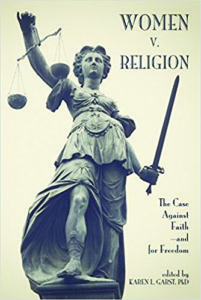Women v. Religion: The Case against Faith—and for Freedom

EDITED BY KAREN L. GARST
PITCHSTONE PUBLISHING, 2018
224 PP.; $16.95
With a bold title like Women v. Religion: The Case against Faith—and for Freedom, Karen L. Garst once again provides an opportunity for women who have suffered at the hands of religious doctrines to speak out. Her first book, Women Beyond Belief: Discovering Life without Religion, showcased the personal stories of everyday women who had left their faith traditions. This newest collection, written by professionals from a variety of fields, focuses more on how women leaving religion benefits both them and society.
Although the struggle for women’s rights in general is experiencing steady progress in many parts of the world, religious dogma remains insidiously regressive and a constant threat to societal advancement. Culturally, the threads of religious indoctrination have been so closely woven into our collective psyches that they’re often difficult to recognize. However, as more and more women turn their backs on religion, it becomes harder to justify such blatant oppression. Even liberal Christians are now being forced to find a way to align their fight for social justice with a holy book that supports the pervasive belief in male superiority and female subjugation.
Garst, who’s the former executive director of the Oregon State Bar and now writes books and a blog called Faithless Feminist, brings together a collection of bright women willing to share their perspectives about what it means to live in a culture that worships old tomes packed full of harmful ideas. Traditionally, women from all over the world have been denied a place at the table with men. The Abrahamic religions in particular have played a strong role in muzzling women; the notion that a woman was responsible for the downfall of humankind and that the female was created as an afterthought to accommodate males is well founded in their holy scriptures.
 It’s inspiring to read contributions from women like Candace Gorham, who has witnessed firsthand through her clinical practice the damage that religion does. Having been diagnosed with posttraumatic stress disorder as a result of being raised in a Christian cult, I myself know the trauma that a young girl faces by experiencing the daily brainwashing of such harmful belief systems. It’s taken years to rid myself of the shame and guilt and find freedom in following my own path. To have my experiences acknowledged and written about, as Gorham does in such depth in her essay, “Guilt, Shame, and Psychological Pain,” is life-affirming.
It’s inspiring to read contributions from women like Candace Gorham, who has witnessed firsthand through her clinical practice the damage that religion does. Having been diagnosed with posttraumatic stress disorder as a result of being raised in a Christian cult, I myself know the trauma that a young girl faces by experiencing the daily brainwashing of such harmful belief systems. It’s taken years to rid myself of the shame and guilt and find freedom in following my own path. To have my experiences acknowledged and written about, as Gorham does in such depth in her essay, “Guilt, Shame, and Psychological Pain,” is life-affirming.
In making her case against faith and for freedom, Garst is careful to include perspectives from women of different backgrounds and religions. Deanna Adams, for example, writes about the experiences of black women in the United States, examining the historical importance of those brought here against their will as slaves and forced to transition from the faith systems of their ethnic groups to patriarchal Christianity. Aruna Papp writes a compelling piece about the somber responsibilities she carried as a child born into a Christian Indian household. Trying to combine the cultural expectations already facing Indian women, she was also burdened with the limitations of Christianity. What an enormous challenge for a young girl.
From the transgender perspective to black and Hispanic experiences to Jewish law and Islam, the accounts in this collection are raw and powerfully persistent. They call our attention to the challenges of being a woman in any culture upholding a belief system of oppression that is supposedly sanctioned by a god. Although each essay is different, they inevitably have one idea in common: religion stands firmly in the way of progress for women. Garst has managed a literary accomplishment that forces us to open our eyes and acknowledge that it’s time to kick these outdated notions to the curb.
